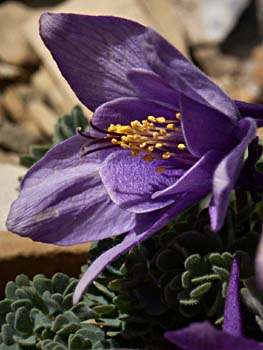Music • Photography • Writing
National Parks Of The American Rockies
Glacier
Page
1
Page
2
Page
3
Page
4
Page
5
Page
6

The views along the trail are well worth the walk. The tallest peak here is Mt. Gould, named for one of Grinnell's friends. It's part of the same ridge as the Garden Wall, and isn't much higher, and not among the tallest peaks in the park. To its right is Bat Wing and below is Grinnell Lake. The aqua water is caused by glacial flour, the finest dust created when the glaciers upslope grind away the rock, which reflects lighter colors of sunlight hitting the water. As I was walking down the trail, I saw what I thought was a log floating in the lake, but it swam across. I met some hikers who said they had watched that big moose swim out on the shore to the left of the photo.
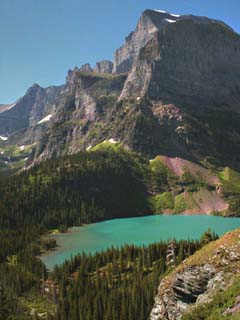
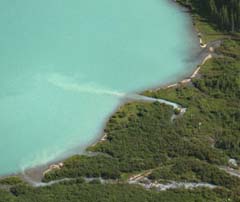
I took this shot of the lake's inlet from the trail, using a telephoto lens. Here meltwater from the glaciers above flows into Grinnell Lake. You can clearly see the glacial flour flowing into the already cyan-colored water. Contrast it with the clear water flowing in from a different stream at upper right. A grizzly bear walked up along this stream shortly before, but at this distance you couldn't see it in the photo if it was there.
I was fortunate to see some bear interactions in Glacier and to watch from a comfortable distance, which makes the photos a bit fuzzy. To the right, a big male grizzly stands up on his back legs to watch a sow and her cubs walk by on the slope below. Male grizzlies take no part in raising the cubs and in fact will often kill them. Sometimes with the death of her cubs, a female will return to breeding. Bears are dangerous to humans, but usually keep their distance.


The sow spotted the male on the slope above and quickly led her cubs out of danger. Note that one cub is dark brown and the other more of a cinnamon color, natural variations that carry through to adulthood.
Moose are a common sight in Glacier as well, sometimes spending the whole day wading through the shallow lakes and eating the underwater plants. Weighing nearly a ton, big bulls are quite formidable and are as often involved in human injuries as the bears. "Velvet," a thin layer of blood-rich skin covered with fine hair, covers the antlers at this time of year, but it will be worn off by fall.
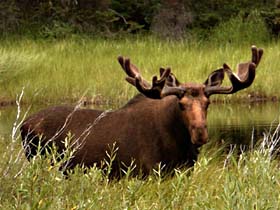
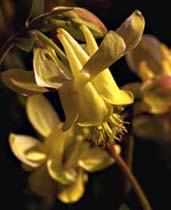
The advantage to photographing flowers instead of wildlife is that flowers hold still (except in the wind) and almost never trample or eat the photographer. These small yellow columbines cover the slopes in summer. The name "columbine" refers to the word dove, and it's easy to see a dove's long neck, spread wings, and wide tail in this photo. I've also photographed red columbines in Missouri, white miniana columbines in the Tetons, as well as the classic blue columbine, the Colorado state flower.
But the flower to the right was a real find for me. This is called a limestone columbine and it grows only on limestone outcrops above timberline. A rare flower, I saw only a few plants and even fewer blossoms, but at least I found this one prime specimen to photograph. (The photo came out pretty well considering the wind was blowing nearly hurricane force.) I've seen many other species reduced to cushion plants above timberline, but this is the only time I've seen a cushion columbine, where the leaves grow only an inch or two above the rocky ground. The flower, however, is huge in comparison, the size of most other columbines, and a deep sky blue.
